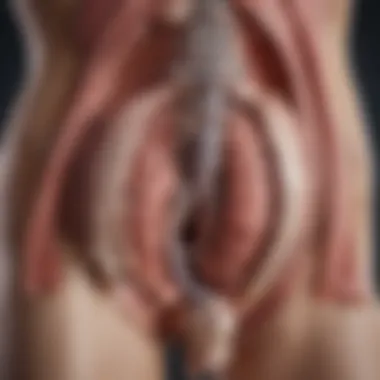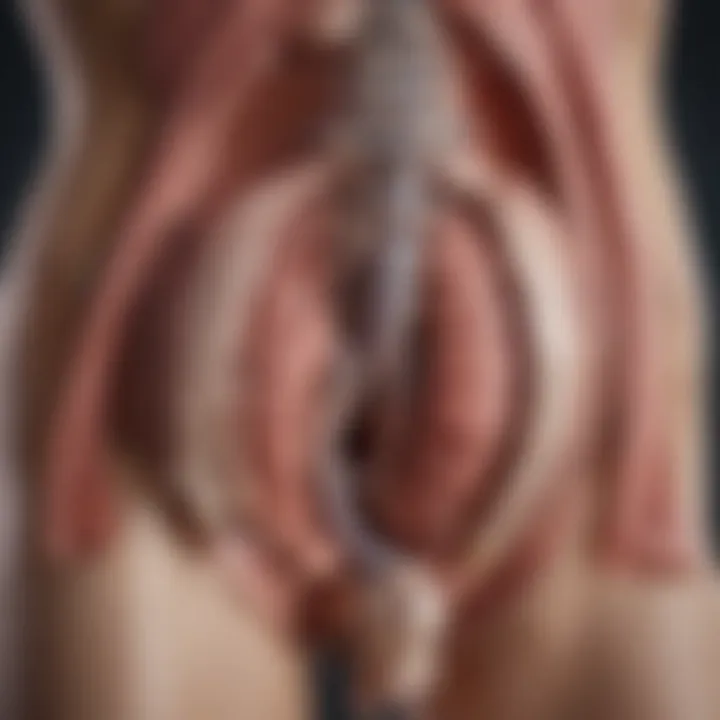Comprehensive Treatment Approaches for Large Hiatus Hernia


Intro
Hiatus hernias are a common condition affecting many individuals, particularly older adults. The large hiatus hernia presents unique challenges, requiring a nuanced understanding of treatment options. This overview aims to shed light on treatment approaches that span non-surgical and surgical modalities.
Diving into the intricacies of large hiatus hernia treatment helps not only in comprehension but also in applications that enhance patient outcomes. Understanding the condition's pathophysiology is the first step in establishing the most effective management strategies. This article also cautiously examines the available diagnostic methods, emphasizing their roles in tailoring interventions to individual circumstances.
As we explore the treatment landscape, special attention will be given to evidence-based practices that address varying patient needs. Whether through lifestyle modifications or surgical interventions, the goal remains to provide a comprehensive guide for healthcare professionals and patients alike.
In the sections that follow, we shall dissect the various treatment strategies, analyze the implications of findings, and provide insights into future directions in management.
Understanding Hiatus Hernias
The significance of comprehending hiatus hernias cannot be overstated in the context of treatment. This section elucidates fundamental aspects of hiatus hernias, touching upon definitions, classifications, and the wider implications of their existence. A robust understanding lays the groundwork for recognizing how these hernias affect patient health, diagnosis, and potential management strategies.
Definition and Scope
A hiatus hernia occurs when part of the stomach protrudes into the thoracic cavity through the diaphragm. This ailment can lead to various complications such as gastroesophageal reflux disease (GERD) and esophageal inflammation. Accurate definition gives clarity about the condition’s nature and scope, guiding healthcare providers in choosing the appropriate intervention.
Types of Hiatus Hernias
Sliding Hiatus Hernias
Sliding hiatus hernias are the most common type, accounting for approximately 95% of all cases. In this form, the junction between the esophagus and stomach slides above the diaphragm. A significant characteristic of sliding hernias is their variability; they can expand or retract based on body posture. This type gains mention in articles due to its prevalence and often milder symptoms compared to other forms. Yet, there are disadvantages; sliding hernias can lead to complications such as reflux, requiring comprehensive evaluation.
Paraesophageal Hiatus Hernias
Paraesophageal hernias present a more critical issue, as a portion of the stomach bulges alongside the esophagus in the thoracic cavity. This type is less common but poses significant risk due to its potential for strangulation or obstruction. Health professionals recognize this type because it often requires surgical intervention, emphasizing the importance of detailing its dangers. While these hernias can be asymptomatic, symptoms can escalate quickly, making this classification crucial for timely treatment.
Mixed Hiatus Hernias
Mixed hiatus hernias combine features of both sliding and paraesophageal types. Patients with this condition may experience a varied range of symptoms. The complexity of mixed hernias makes their management challenging, as they necessitate a tailored approach to treatment. This mixture can complicate diagnosis, thus making a deep understanding important for practitioners.
Epidemiology and Risk Factors
Epidemiological studies reveal considerable insights into the demographic factors influencing hiatus hernias, thus shaping prevention strategies and treatment protocols. Comprehensive knowledge about the risk elements helps create targeted management plans.
Age and Gender Disparities
Age and gender play significant roles in the prevalence of hiatus hernias. Older populations, particularly those over fifty, show higher instances, likely due to weakening of the diaphragm and connective tissues. Gender disparities also exist, with women often being more affected. Recognizing these demographics aids in identifying at-risk groups for proactive intervention.
Obesity and Lifestyle Factors
Obesity is a major risk factor, contributing to increased abdominal pressure which can lead to herniation. Lifestyle choices such as diet and physical activity influence these patterns. Together, these factors promote better preventive strategies and inform patients about lifestyle modifications necessary for reducing risk.
Genetic and Anatomical Predispositions
Genetic and anatomical predispositions contribute to the development of hiatus hernias. Some individuals may have a hereditary tendency that affects the structure or strength of the diaphragm. This understanding emphasizes the need for family medical histories to inform clinical decisions and guide preventative measures.
Understanding these factors not only informs treatment but helps anticipate necessary interventions based on individual patient needs.
Pathophysiology of Large Hiatus Hernias
Understanding the pathophysiology of large hiatus hernias is crucial for healthcare professionals and patients alike. It sheds light on the underlying mechanisms that lead to the condition and the resultant symptoms. By grasping these concepts, clinicians can make informed decisions about treatment options, while patients can better understand their health status.
Mechanisms of Herniation
Herniation occurs when a portion of the stomach protrudes through the diaphragm into the thoracic cavity. The primary mechanism involves an increase in intra-abdominal pressure combined with a laxity of the anatomical structures that normally confine the stomach. Factors such as obesity, aging, and certain lifestyle choices may exacerbate this condition, leading to large hiatus hernias.
The esophageal hiatus, a natural opening in the diaphragm, becomes the site of concern here. In individuals with a large hiatus hernia, the increased pressure from factors such as heavy lifting, straining during bowel movements, or even chronic coughing can facilitate the herniation process. Recognizing these mechanisms is essential for tailoring treatment plans and managing symptoms effectively.
Symptomatology
The symptomatology associated with large hiatus hernias is diverse, and understanding it assists in diagnosing and managing the condition. Key symptoms include:
- Gastroesophageal Reflux Disease
- Esophageal Stricture
- Chest Pain and Dysphagia
Gastroesophageal Reflux Disease
Gastroesophageal reflux disease (GERD) is one of the most common symptoms linked to large hiatus hernias. This condition occurs when stomach acid flows back into the esophagus, causing irritation and discomfort. The key characteristic of GERD is the frequent occurrence of heartburn, a burning sensation in the chest. It is also tied to the hernia’s ability to disrupt normal esophageal function, leading to incomplete closure of the lower esophageal sphincter. This characteristic makes it a relevant focus in this article, given its clinical significance.
A unique feature of GERD in the context of hiatus hernias is its potential to lead to erosive esophagitis, especially if left untreated. This presents both advantages and disadvantages: while effective medical therapies exist, untreated GERD can result in severe complications, necessitating more invasive treatments.
Esophageal Stricture
Esophageal stricture occurs when scarring narrows the esophagus, often as a result of chronic acid exposure from GERD. This condition is particularly concerning because it can cause swallowing difficulties, known as dysphagia. The key characteristic of esophageal stricture is its potential to significantly impact the quality of life. Its importance in this article stems from its direct link to long-term complications associated with hiatus hernias.
The unique feature of esophageal stricture is that it can be amenable to treatment through dilation procedures. However, the stricture can recur, leading to ongoing management challenges for patients and healthcare providers alike.
Chest Pain and Dysphagia
Chest pain and dysphagia add another layer of complexity to the symptomatology of large hiatus hernias. Chest pain, often mistaken for cardiac issues, can significantly alarm patients. The key characteristic here is the non-cardiac nature of chest pain resulting from reflux or esophageal irritation. This distinction is vital for accurate diagnosis.
Dysphagia, or difficulty swallowing, can manifest in individuals with large hiatus hernias due to the anatomical changes that disrupt normal esophageal transit. The presence of dysphagia raises concerns about aspiration and nutritional intake, making it a critical focus for both patients and clinicians.
It is essential to differentiate these symptoms clearly as they play an important role in the overall management strategy for patients with large hiatus hernias.
Understanding these symptoms and their mechanisms allows for a more comprehensive approach to treatment. Clinicians can prioritize interventions that address these specific issues, and patients can better articulate their experiences, leading to more effective care.
Diagnosis of Hiatus Hernias


The diagnosis of hiatus hernias serves as a crucial step in determining appropriate treatment strategies. Accurate diagnosis is significant for both healthcare professionals and patients. It helps in recognizing the condition early, which can lead to better management and outcomes. Furthermore, understanding how to identify hiatus hernias lays the groundwork for effective treatment planning.
Clinical Evaluation
A thorough clinical evaluation is often the first step in diagnosing hiatus hernias. Healthcare providers typically begin with a detailed patient history and physical examination. Patients may report symptoms such as heartburn, chest pain, or difficulty swallowing. These symptoms can sometimes lead to misdiagnosis, which is why a cautious and systematic approach is essential during evaluation.
Symptoms can vary widely from one individual to another. A clear understanding of the patient’s lifestyle, dietary habits, and any previous medical conditions can also provide added insight into potential causes. Often, a detailed history can guide further diagnostic testing and help distinguish hiatus hernias from other gastrointestinal disorders.
Imaging Techniques
Imaging techniques are vital diagnostic tools that aid in visualizing hiatus hernias. Several methods can be employed, each with specific strengths and possible limitations. The choice of imaging technique often depends on the clinical scenario, availability of resources, and specific patient needs.
Upper Gastrointestinal Series
The Upper Gastrointestinal Series (UGI) is a radiological examination that utilizes X-rays to evaluate the upper GI tract. This procedure involves the patient swallowing a barium sulfate solution, which helps outline the esophagus, stomach, and duodenum on X-ray images.
One key characteristic of UGI is its non-invasive nature, making it a favorable choice for initial assessments. This examination can effectively reveal the presence of a sliding hiatus hernia and other abnormalities. However, it may not provide detailed images of the esophageal lining or support visualizing paraesophageal hernias. Some patients also experience discomfort during barium ingestion, which can be a minor downside to this method.
Endoscopy
Endoscopy is a procedure that involves inserting a flexible tube equipped with a camera into the esophagus and stomach. This allows for direct visualization of the mucosal surfaces, aiding in the assessment of any abnormalities that may be present due to a hiatus hernia.
One significant advantage of endoscopy is its ability to perform diagnostic and therapeutic interventions simultaneously. For instance, it can help identify complications associated with hiatus hernias, such as esophagitis or strictures. However, it is considered a more invasive method compared to UGI, and it may require sedation, which carries its own set of risks.
CT Scans
CT scans are another imaging option where a series of detailed cross-sectional images of the abdomen are captured. This technique provides a comprehensive view of the anatomical structures and can effectively identify hiatus hernias, particularly in complex cases.
CT scans are beneficial for their high-resolution imaging and capability to evaluate adjacent structures. The downside, however, can be exposure to higher radiation levels compared to UGI. Additionally, they are generally more expensive and may not be available in all healthcare settings.
Differential Diagnosis
Considering other potential diagnoses is essential when evaluating hiatus hernias. Many gastrointestinal conditions can present similarly, including gastroesophageal reflux disease, esophageal varices, and peptic ulcers. Proper differential diagnosis aids in preventing misdiagnosis and ensures that patients receive appropriate treatment for their specific condition.
Accurate diagnostic approach can lead to significant improvements in patient management and outcomes.
Non-Surgical Treatment Options
Non-surgical treatment options play a crucial role in managing large hiatus hernias. These approaches often serve as first-line therapies aimed at alleviating symptoms and improving the quality of life for patients. Successful management can sometimes prevent the need for surgery, making these interventions particularly valuable in comprehensive treatment planning.
The non-surgical options include lifestyle modifications, medications, and regular monitoring. Each of these elements has unique characteristics contributing to their efficacy. They focus on alleviating symptoms, adjusting behaviors, and utilizing pharmacological aids, all of which can significantly lessen the burden of the condition while promoting overall patient health.
Lifestyle Modifications
Dietary Changes
Dietary changes are essential for minimizing symptoms associated with large hiatus hernias. Foods that trigger reflux should be identified and limited. Common culprits include spicy foods, fatty meals, and caffeine. The key characteristic here is the role of diet in maintaining a favorable pH balance in the stomach. These changes not only help to reduce discomfort but also can potentially mitigate long-term risks related to reflux.
The unique feature of dietary changes is their non-invasive nature. They can be easily adapted into a person's lifestyle. However, adherence to these changes may vary, as personal preferences and social situations often influence eating habits.
Weight Management
Weight management is another critical aspect that influences the symptoms of large hiatus hernias. Excess weight can place additional pressure on the abdomen, compounding the issues with reflux and herniation. The key characteristic of weight management lies in its dual benefits: it aims to alleviate symptoms while improving overall health. Achieving a healthy weight can be a beneficial choice, as it directly correlates with symptom relief.
The uniqueness of this approach lies in the continuous nature of managing one’s weight. While many health interventions have definitive endpoints, weight management is an ongoing process that may involve lifestyle changes and education on nutrition and physical activity. Its disadvantage can also be the effort and discipline required to maintain a healthy weight.
Posture and Activity Adjustments
Posture and activity adjustments can be fundamental in managing a hiatus hernia. Good posture, particularly upright positioning after meals, can facilitate proper digestion and minimize reflux episodes. The key characteristic here is the physiological effect of posture on the abdominal cavity. Proper alignment can reduce the pressing of the stomach against the diaphragm, which may lead to fewer symptoms.
A distinct advantage of this approach is that it does not involve medications or strict diets; rather, it encourages conscious modifications to daily habits. However, its efficacy may vary among individuals, and changes may be harder to implement consistently over time.
Medications
Medications serve as an essential adjunct to lifestyle changes in the context of large hiatus hernias. They are designed to alleviate symptoms and reduce the acid production that can exacerbate discomfort.
Proton Pump Inhibitors
Proton pump inhibitors (PPIs) are commonly prescribed to patients with hiatus hernias. They work by significantly decreasing stomach acid production, which aids in healing the esophagus and alleviating symptoms like heartburn. The key characteristic of PPIs is their ability to provide long-term symptom relief for chronic conditions.
Their unique feature is they can offer substantial improvement for those suffering from gastroesophageal reflux disease (GERD) related symptoms. However, prolonged use can lead to side effects, including nutrient malabsorption and increased risk of infections, which warrants careful consideration.
-Receptor Antagonists
-receptor antagonists are another class of medications used in the management of hiatus hernias. These drugs work by blocking histamine receptors in the stomach, leading to reduced acid production. Their key characteristic is the relatively quick onset of action compared to PPIs.
The unique advantage of -receptor antagonists is they can be used as needed, making them a flexible option for symptom control. However, tolerance can develop over time, limiting their long-term effectiveness.
Antacids
Antacids are over-the-counter medications that neutralize stomach acid. Their role is pivotal for immediate relief of symptoms such as heartburn. The key characteristic of antacids is their fast-acting nature, providing prompt symptom relief.
One unique feature of antacids is they are accessible without a prescription and can be used in conjunction with other medications. But, they often provide only temporary relief and may need to be used multiple times a day, which can be inconvenient for some individuals.
Monitoring and Follow-Up
Monitoring and follow-up are vital to ensuring the effectiveness of both lifestyle changes and medications. Regular check-ups allow healthcare providers to assess symptom improvement, evaluate the need for adjustments in treatment, and detect any potential complications early.
Consistent monitoring helps create a collaborative approach between patients and physicians, promoting adherence to management plans and ensuring that emerging issues are promptly addressed. This facet cannot be understated, as effective treatment often relies on proactive engagement and education about one’s health.
Surgical Treatment Approaches


Surgical treatment approaches are vital for managing large hiatus hernias when conservative methods fail or symptoms become severe. Understanding when surgery is necessary and the different types available can significantly improve patient outcomes. Surgical options can provide relief from debilitating symptoms, restoring quality of life and preventing complications that might arise with untreated hernias.
Indications for Surgery
Surgery for hiatus hernias is generally indicated when non-surgical treatments do not yield satisfactory results. Patients often seek surgical intervention when they experience persistent gastroesophageal reflux disease, severe dysphagia, or significant chest pain not managed by medications or lifestyle changes.
Other factors include:
- Emergence of complications such as esophagitis or stricture.
- The size and type of the hernia — larger hernias may have higher complications risk if left untreated.
- The overall impact on daily life and ability to perform regular activities.
Evaluating these aspects ensures that surgery is conducted for appropriate candidates, improving the likelihood of successful interventions.
Types of Surgical Procedures
The surgical procedures for addressing large hiatus hernias include various techniques tailored to individual patient needs.
Laparoscopic Fundoplication
Laparoscopic Fundoplication is considered a minimally invasive procedure characterized by its smaller incisions and reduced recovery time compared to open surgery. It involves wrapping the top of the stomach around the lower esophagus, providing support and reinforcing the lower esophageal sphincter. This procedure effectively alleviates symptoms associated with gastroesophageal reflux disease and stabilizes the herniated area.
Key characteristics:
- Minimally invasive with quicker recovery.
- Lower postoperative pain and shorter hospital stays.
Unique features include the use of advanced technological instrumentation, allowing for precision in the procedure. It is beneficial due to its ability to minimize the stress and risk associated with larger incisional surgeries.
Advantages:
- Faster recovery times.
- Less postoperative pain.
Disadvantages:
- Potential risk of complications related to minimally invasive techniques, such as gas embolism.
Open Fundoplication
Open Fundoplication is a more traditional approach, suitable in cases where laparoscopic techniques may not be advisable due to the patient’s condition or previous surgeries. This procedure involves a longer incision in the abdomen, providing direct access to the esophagus and stomach.
Key characteristics:
- Direct exposure to abdominal organs.
- Suitable for complex cases or large hiatal hernias.
The unique feature of open approaches allows surgeons to address any incidental findings during the surgery. While this method is effective, it is often associated with a longer recovery period and increased postoperative discomfort.
Advantages:
- Ability to handle complex cases.
- Greater visibility for the surgeon.
Disadvantages:
- Longer recovery time.
- Increased risk of infection or complications due to larger incisions.
Hiatal Hernia Repair Techniques
Hiatal hernia repair techniques encompass various surgical methods aimed at restoring proper anatomy. These might include additional interventions like gastropexy, where the stomach is anchored to the diaphragm, or mesh placement for support.
Key characteristics:
- Restoration of anatomical relationships.
- Use of synthetic mesh for added reinforcement in some cases.
The techniques can be adapted based on the type and size of hernia. Their main benefit lies in their potential to prevent recurrence of hernias post-surgery, which is a significant consideration in patient outcomes.
Advantages:
- Reduction in hernia recurrence rates.
- Improved structural support for the digestive system.
Disadvantages:
- Risk of complications from foreign materials, if synthetic mesh is used.
- Possible need for additional procedures if complications arise.
Postoperative Care and Recovery
Postoperative care is critical for achieving a successful recovery. Ensuring patients know what to expect during the recovery phase can significantly ease their transition back to normal activities.
Pain Management
Pain management is crucial for postoperative comfort and essential in aiding recovery. Effective pain control helps patients engage in physical therapy earlier, which is important for healing.
Key characteristics:
- Use of analgesics to control pain levels.
- Assessment of pain levels regularly to adjust medication as needed.
Unique features include both pharmacological methods and non-pharmacological techniques like guided imagery. Prioritizing pain management can enhance patient satisfaction and promote recovery, but it must be balanced to avoid over-reliance on medications.
Advantages:
- Enhanced patient comfort.
- Increased mobility and participation in recovery activities.
Disadvantages:


- Potential for overmedication or side effects.
Dietary Considerations
Dietary considerations post-surgery focus on gradual reintroduction of foods to prevent discomfort or complications like reflux. Initially, a clear liquid diet is recommended, gradually advancing to a soft diet before resuming regular foods.
Key characteristics:
- Careful monitoring of dietary intake.
- Avoidance of irritants like spicy or acidic foods following surgery.
Unique features entail working with nutritionists to create tailored recovery meal plans. This careful approach can prevent postoperative complications and aid in recovery, ensuring patients regaining fondness for food choices.
Advantages:
- Reduces risk of exacerbating reflux symptoms during recovery.
- Encourages healthy eating habits moving forward.
Disadvantages:
- Need for monitoring to ensure dietary changes are effective.
Activity Restrictions
Activity restrictions post-surgery play a crucial role in recovery, as they help prevent strain on the surgical site. Patients are often advised to avoid heavy lifting and intense physical activities for a specified period.
Key characteristics:
- Guidelines set for gradual return to normal activities.
- Avoidance of activities that could compromise recovery.
Unique features include follow-up consultations where activity levels are regularly evaluated. This framework ensures that patients understand their limits and avoid the temptation to resume their routines too quickly, which could jeopardize healing.
Advantages:
- Helps to avoid complications and hernia recurrence.
- Promotes a structured recovery plan.
Disadvantages:
- Potential frustration for patients eager to return to regular activity.
In summary, surgical treatment approaches for large hiatus hernias encompass careful planning, execution, and management post-surgery to achieve successful outcomes.
Attention to each of these stages is vital to ensure both immediate relief of symptoms and long-term health stability.
Complications Associated With Large Hiatus Hernias
Understanding the complications that arise from large hiatus hernias is crucial in the comprehensive treatment and management of this condition. These complications can range from surgical issues that occur during the intervention process to long-term challenges that affect patient quality of life. Recognizing these complications helps both healthcare professionals and patients in developing effective strategies for treatment and monitoring.
Potential Surgical Complications
Infection
Infection is a common risk associated with surgical procedures for hiatus hernias. The open nature of surgery increases the likelihood of pathogens entering the surgical site. One of the key characteristics of infection is its capacity to delay recovery and complicate postoperative management. Addressing infection promptly is essential as it can compromise the surgical outcome. In this article, understanding infection can highlight the importance of postoperative care. The unique feature of managing infection includes the need for antibiotics, which can be beneficial in preventing severe complications. However, overuse of antibiotics can lead to resistance, which presents disadvantages in treatment protocols.
Recurrence of Hernia
Recurrence of a hiatus hernia following surgical repair is a significant concern. The likelihood of recurrence emphasizes the need for robust surgical techniques and thorough patient evaluation. A notable characteristic of recurrence is that it can cause the return of the original symptoms, disrupting the patient's life. This topic is particularly beneficial in this article, as understanding recurrence assists in preparing patients for potential future surgeries. The unique aspect of recurrence involves both anatomical and lifestyle factors that can contribute to this issue. While some patients may experience a smooth recovery, others may face multiple interventions, creating a challenging patient pathway.
Esophageal Injury
Esophageal injury is a serious risk during surgical procedures and can lead to significant complications long after the surgery. The key characteristic of esophageal injury lies in its potential to result in severe dysphagia or other esophageal dysfunctions. This topic offers valuable insights into surgical risks, making it a crucial aspect of this article. The unique feature of esophageal injury is its impact on both physical health and psychological well-being. Patients may suffer from persistent symptoms that can affect their quality of life. Thus, highlighting this complication emphasizes the need for skilled surgical strategies and rigorous postoperative monitoring.
Long-term Management Challenges
Chronic Reflux
Chronic reflux is a long-term complication that many patients face after surgery for hiatus hernia. The persistent nature of reflux can severely affect the patient’s quality of life. A key characteristic of chronic reflux is its implication on daily activities, leading to difficulties such as dietary restrictions and the need for ongoing medical management. Understanding chronic reflux is vital, as it provides insight into symptom management and the potential requirement for additional treatments. The unique challenge of this complication is the need for continuous adaptation of lifestyle and dietary habits, which some patients may find difficult.
Strictures and Barrett's Esophagus
Strictures, or narrowing of the esophagus, can occur after surgical interventions. This can lead to significant swallowing difficulties and the need for further treatment. Barrett's esophagus is another complication that may arise, representing a progression from chronic reflux. The key characteristic of these conditions is the risk they pose for developing esophageal cancer, making them a critical focus in long-term management. Understanding these complications highlights the importance of ongoing surveillance in patients. Unique to this topic is the necessity for regular endoscopic evaluations, which can be both advantageous and burdensome for patients.
Need for Reoperation
The potential need for reoperation is an important consideration in managing hiatus hernias. Various factors can contribute to this need, including complications from initial surgery or recurrence of the hernia itself. The key characteristic of this issue is its impact on patient prognosis and stress. This article emphasizes the relevance of discussing the possibility of reoperation with patients. Understanding this need underscores the importance of setting realistic expectations post-surgery, particularly concerning recovery and symptom relief. Unique to this aspect is the complexity it adds to patient’s treatment timelines, which can lead to psychological implications as well.
Future Perspectives and Research Directions
Understanding the evolving landscape of hiatus hernia treatment not only enhances patient outcomes but also informs healthcare professionals on future trends. This section outlines the significance of innovative techniques, rigorous research on patient outcomes, and the integration of technology in managing large hiatus hernias.
Innovative Treatment Techniques
Recent advancements in medical technology are expanding treatment options for large hiatus hernias. Novel approaches are focusing on minimizing invasiveness while maximizing effectiveness. One promising area is the use of robotic-assisted surgery. This technique offers precision in surgical maneuvers, potentially leading to better postoperative recovery and reduced complication rates.
Another emerging treatment involves transcatheter approaches, where endoscopic techniques can be applied to manage smaller hiatus hernias without the need for extensive surgical interventions. These procedures might offer faster recovery times and less discomfort for patients. Clinical trials assessing these innovative methods are essential to establish their efficacy and safety.
Research on Patient Outcomes
Patient outcomes serve as a cornerstone for evaluating the success of treatment methods. Research is increasingly focusing on long-term impacts of various interventions on quality of life and symptom relief. Studies are examining not just immediate post-surgical recovery but also the long-term durability of the treatments.
Data collection through patient registries is imperative. Comprehensive analysis from these registries can illuminate patterns related to patient demographics, treatment choices, and outcomes. This information can direct future guidelines and help in tailoring treatment strategies to individual patient profiles. As such, this research is crucial for a more personalized approach toward managing hiatus hernias.
Role of Technology in Management
Technology plays an important role in the management landscape of hiatus hernias. The integration of artificial intelligence is changing diagnostic and treatment paradigms. Machine learning algorithms can assist in identifying at-risk patients through predictive analytics based on clinical data and imaging results.
Furthermore, telehealth platforms have gained prominence, allowing for continuous patient engagement and monitoring. Such technology enables timely adjustments to treatment plans without necessitating frequent in-office visits. This aspect is especially beneficial for managing chronic conditions associated with hiatus hernias, ensuring ongoing support and education.
Overall, the future of hiatus hernia management relies on innovation, evidence-based research, and technological advancement. By understanding these dimensions, stakeholders can improve the quality of care provided to patients, thus achieving better health outcomes.















